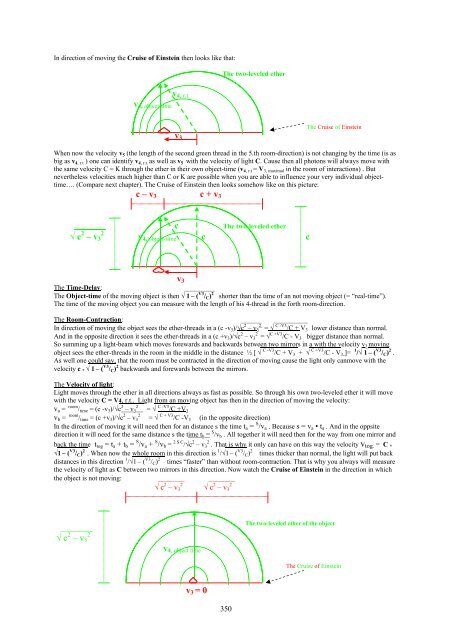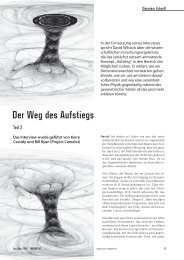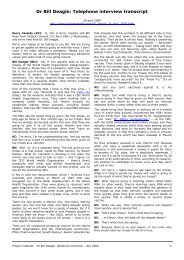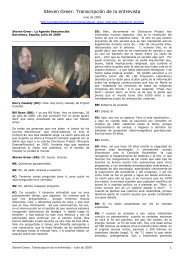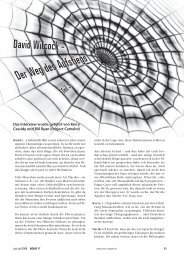The 'New Berlin' base: Nazis in the Antarctic - Project Camelot
The 'New Berlin' base: Nazis in the Antarctic - Project Camelot
The 'New Berlin' base: Nazis in the Antarctic - Project Camelot
Erfolgreiche ePaper selbst erstellen
Machen Sie aus Ihren PDF Publikationen ein blätterbares Flipbook mit unserer einzigartigen Google optimierten e-Paper Software.
In direction of mov<strong>in</strong>g <strong>the</strong> Cruise of E<strong>in</strong>ste<strong>in</strong> <strong>the</strong>n looks like that:<br />
v4, object-time<br />
v4, r.t.<br />
v3<br />
<strong>The</strong> two-leveled e<strong>the</strong>r<br />
350<br />
<strong>The</strong> Cruise of E<strong>in</strong>ste<strong>in</strong><br />
When now <strong>the</strong> velocity v 5 (<strong>the</strong> length of <strong>the</strong> second green thread <strong>in</strong> <strong>the</strong> 5.th room-direction) is not chang<strong>in</strong>g by <strong>the</strong> time (is as<br />
big as v4, r.t ) one can identify v 4, r.t. as well as v 5 with <strong>the</strong> velocity of light C. Cause <strong>the</strong>n all photons will always move with<br />
<strong>the</strong> same velocity C = K through <strong>the</strong> e<strong>the</strong>r <strong>in</strong> <strong>the</strong>ir own object-time (v 4, r.t = V 3, maximal <strong>in</strong> <strong>the</strong> room of <strong>in</strong>teractions) . But<br />
never<strong>the</strong>less velocities much higher than C or K are possible when you are able to <strong>in</strong>fluence your very <strong>in</strong>dividual objecttime….<br />
(Compare next chapter). <strong>The</strong> Cruise of E<strong>in</strong>ste<strong>in</strong> <strong>the</strong>n looks somehow like on this picture:<br />
c – v3 c + v3<br />
c <strong>The</strong> two-leveled e<strong>the</strong>r<br />
√ c 2 – v3 2 v4, object-time c c<br />
v3<br />
<strong>The</strong> Time-Delay: _________<br />
<strong>The</strong> Object-time of <strong>the</strong> mov<strong>in</strong>g object is <strong>the</strong>n √ 1 – ( V3 / C) 2 shorter than <strong>the</strong> time of an not mov<strong>in</strong>g object (= “real-time”).<br />
<strong>The</strong> time of <strong>the</strong> mov<strong>in</strong>g object you can measure with <strong>the</strong> length of his 4-thread <strong>in</strong> <strong>the</strong> forth room-direction.<br />
<strong>The</strong> Room-Contraction: ______ __________<br />
In direction of mov<strong>in</strong>g <strong>the</strong> object sees <strong>the</strong> e<strong>the</strong>r-threads <strong>in</strong> a (c -v3)/√c 2 – v 3 2 = √ C -V3 /C + V3 lower distance than normal.<br />
And <strong>in</strong> <strong>the</strong> opposite direction it sees <strong>the</strong> e<strong>the</strong>r-threads <strong>in</strong> a (c +v3)/√c 2 – v 3 2 = √ C +V3 /C - V3 bigger distance than normal.<br />
So summ<strong>in</strong>g up a light-beam which moves forewards and backwards between two mirrors <strong>in</strong> a with <strong>the</strong> velocity v 3 mov<strong>in</strong>g<br />
object sees <strong>the</strong> e<strong>the</strong>r-threads <strong>in</strong> <strong>the</strong> room <strong>in</strong> <strong>the</strong> middle <strong>in</strong> <strong>the</strong> distance ½ [ √ C -V3 /C + V 3 + √ C +V3 /C - V 3 ]= 1 /√ 1 – ( V3 / C) 2 .<br />
As well one could say, that <strong>the</strong> room must be contracted <strong>in</strong> <strong>the</strong> direction of mov<strong>in</strong>g cause <strong>the</strong> light only canmove with <strong>the</strong><br />
velocity c * √ 1 – ( V3 / C) 2 backwards and forewards between <strong>the</strong> mirrors.<br />
<strong>The</strong> Velocity of light:<br />
Light moves through <strong>the</strong> e<strong>the</strong>r <strong>in</strong> all directions always as fast as possible. So through his own two-leveled e<strong>the</strong>r it will move<br />
with <strong>the</strong> velocity C = V4, r.t.. Light from an mov<strong>in</strong>g object has <strong>the</strong>n <strong>in</strong> <strong>the</strong> direction of mov<strong>in</strong>g <strong>the</strong> velocity:<br />
va = room / time = (c -v3)/√c 2 2 C -V3<br />
– v3 = √ /C +V3<br />
vb = room / time = (c +v3)/√c 2 2 C + V3<br />
– v3 = √ /C -V3 (<strong>in</strong> <strong>the</strong> opposite direction)<br />
In <strong>the</strong> direction of mov<strong>in</strong>g it will need <strong>the</strong>n for an distance s <strong>the</strong> time ta = S /va . Because s = va • ta . And <strong>in</strong> <strong>the</strong> oppsite<br />
direction it will need for <strong>the</strong> same distance s <strong>the</strong> time tb = S /vb . All toge<strong>the</strong>r it will need <strong>the</strong>n for <strong>the</strong> way from one mirror and<br />
back <strong>the</strong> time ttog = ta + tb = S /va + S /vb = 2 S C /√c 2 2<br />
– v3 . That is why it only can have on this way <strong>the</strong> velocity vtog. = C *<br />
√1 – ( V3 / C) 2 . When now <strong>the</strong> whole room <strong>in</strong> this direction is 1 /√1 – ( V3 / C) 2 times thicker than normal, <strong>the</strong> light will put back<br />
distances <strong>in</strong> this direction 1 /√1 – ( V3 / C) 2 times “faster” than without room-contraction. That is why you always will measure<br />
<strong>the</strong> velocity of light as C between two mirrors <strong>in</strong> this direction. Now watch <strong>the</strong> Cruise of E<strong>in</strong>ste<strong>in</strong> <strong>in</strong> <strong>the</strong> direction <strong>in</strong> which<br />
<strong>the</strong> object is not mov<strong>in</strong>g: _______ _______<br />
√ c 2 – v3 2 √ c 2 – v3 2<br />
_______<br />
√ c 2 – v3 2<br />
v4, object time<br />
v3 = 0<br />
<strong>The</strong> two-leveled e<strong>the</strong>r of <strong>the</strong> object<br />
<strong>The</strong> Cruise of E<strong>in</strong>ste<strong>in</strong>


